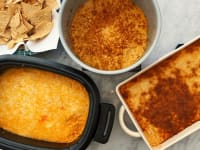This is how to cut butternut squash (and turn it into tasty soup)
'Tis the season for gourds galore
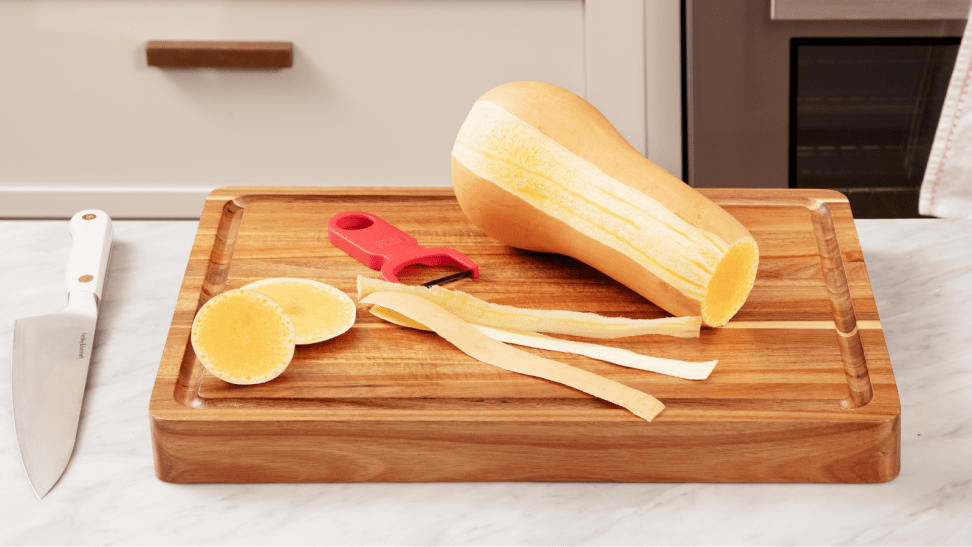 Credit:
Reviewed / Timothy Renzi
Credit:
Reviewed / Timothy Renzi
Products are chosen independently by our editors. Purchases made through our links may earn us a commission.
The leaves are falling and football season is in full swing. You know what that means: It's time to start cooking with seasonal produce stars like butternut squash. But before you storm the farmers market and start googling "butternut squash soup recipes" (we have an easy one for you below), you need to learn the right prep techniques.
Cutting into a hefty and tough gourd like butternut squash can be dangerous without the right tools and techniques. But don't worry, we've lined up all the steps you need to follow for success.
How to cut butternut squash
1. Trim the ends

The top and bottoms ends will be the first to go when cutting into a butternut squash.
Before you start peeling, set yourself up for success: Trim the stem and bottom end of the squash first. This will make it easier to peel evenly across the squash.
But make sure you have a spacious cutting board and a strong and sturdy chef's knife to work with. Our favorite knife is from Hedley & Bennett because it features a comfortable handle and lightweight design that makes for excellent control.

Showcase your culinary skills on a premium cutting board made from sustainable Acacia wood.

Precise cuts with minimal effort are achievable due to this blade's three layers of Japanese steel.
2. Use a Y-peeler to remove the skin
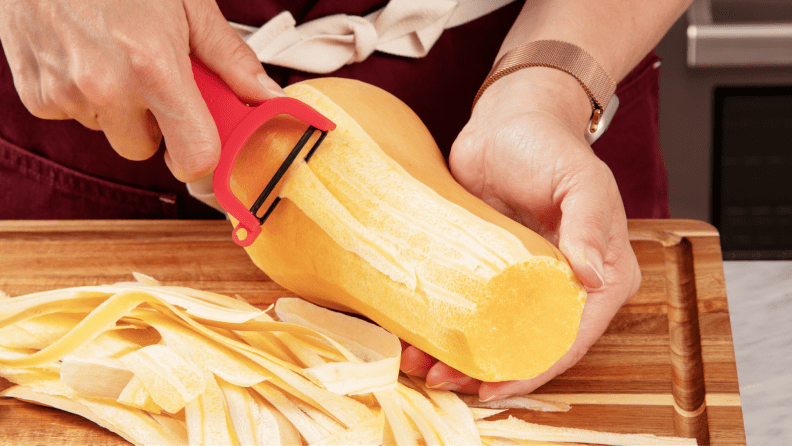
We always recommend opting for a Y-peeler for seamless peeling.
That tough skin can be hard to remove with the wrong peeler. We always opt for a good Y-peeler, in order to effortlessly graze through the skin without having to cramp your hand in the process.
Once you've finished, do not throw your peels in the garbage disposal! This can break the disposal and lead to clogged drains. Instead, toss them in the trash or in your composter.
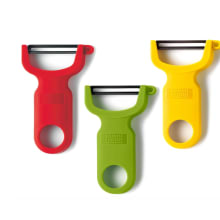
Instead of practicing an old-fashioned method of peeling with a knife, go for a more ergonomic peeler.
3. Cut the squash, separating the neck from the bulb

Create a flat-edged surface for each side of the squash for easy slicing.
This technique will be the easiest way to achieve even cubes or slices—without slipping or cutting yourself in the process.
Place the squash horizontally and slice it along the curve, separating the cylindrical neck of the squash from the rounded bottom. This gives you two flat-bottomed surfaces to work with!
4. Slice the bulb section in half, and remove the seeds

Pro tip: Use a durable ice cream scoop to remove all that pulp and seeds from the squash.
All of the seeds in a butternut squash are housed in the rounded bulb portion. So cut into that part first, slicing the squash in half to reveal the seeds and pulp.
Next, use a large sharp-edged spoon or ice cream scoop to remove the seeds and pulp. These can also go in your compost bin, or you can separate the seeds out and roast them for an easy seasonal snack. (These aren't as tasty as pumpkin seeds, but they are nutritious!)

This stainless steel ice cream is versatile so it’ll double as a useful aid in gutting seeds.
5. Slice and cube the bulb
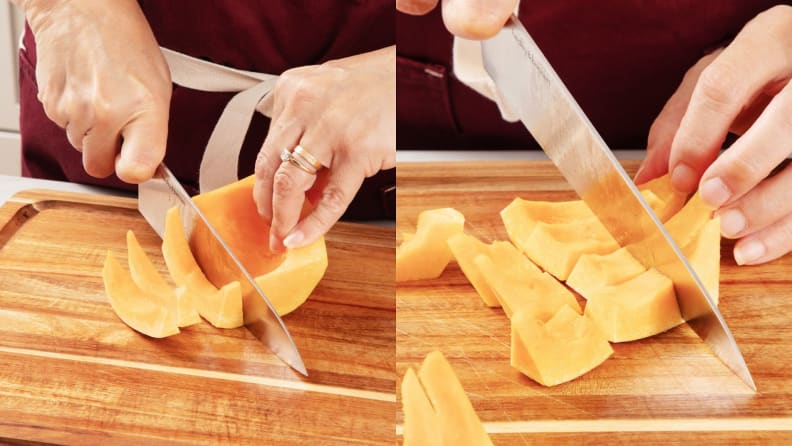
To achieve cubes from the squash's bowl, slice them lengthwise first.
If you're roasting your squash, you'll want to cut it into small and even pieces to achieve a soft and evenly cooked texture. You can opt to either just slice them vertically and roast them as is, or cube the slices afterwards for more uniformity.
6. Halve the neck lengthwise, then cut into cubes

The flat surface on the neck makes it easy to halve it for cubing.
Use the flat surface you created earlier to support a lengthwise slice into the neck of the squash. This will leave you with two halves that are easy to slice into three sections and cut into even cubes for easy roasting.
Your butternut squash is prepped! Now what?

No matter what shape you opt for, roasted butternut squash will always be tasty.
If you've gotten this far, we imagine you already have a recipe in mind for enjoying your treasured gourd. Whether it's a simple roasted side dish, fall risotto, or cozy curry, butternut squash can go a long way in a variety of seasonal recipes.
One of our favorite ways to enjoy this seasonal vegetable is in a simple roasted butternut squash soup. It only requires a few ingredients and comes together quickly with a powerful blender.
Roasted butternut squash soup

This recipe comes together with minimal effort—and tastes like fall in a bowl.
Ingredients
- 1 large butternut squash (about 2 pounds)
- 2 Golden Delicious apples (about 3/4 pound)
- 2 large shallots
- 2 tbsp olive oil
- 4 cups vegetable broth or chicken broth, hot
- 1 tbsp maple syrup
- 1 tsp apple cider vinegar
- Salt and pepper (to taste)
- Apple cider (to taste)
- Ground nutmeg (to taste)
Tools
Step 1: Prep
Preheat the oven to 450°F. While it's heating up, prep your butternut squash, apple, and shallot. Cut the squash according to the instructions above. Peel and cut the apple into 1/4-inch thick slices, and peel and slice the shallot into wedges.
Step 2: Roast
Place all the ingredients in an even layer on a baking sheet. Coat everything with a drizzle of olive oil and salt and pepper to taste. Then place the baking sheet in the oven and roast for about 45 minutes, stirring halfway through roasting, until all the ingredients have cooked through and browned. Scrape up any roasted bits left on the pan. (You can use a bit of water or broth to help with this.)
Step 3: Blend
Place all the roasted veggies in a powerful blender, like the Vitamix A3500, and add the liquid ingredients. Blend until fully combined and smooth. Add the maple syrup and cider vinegar to taste. If the soup is too thick, you can thin it with some apple cider to taste (or broth if you don’t have apple cider). Serve hot with toppings of your choice (think croutons, pumpkin seeds, sour cream, fresh herbs!). Sprinkle with a dash of ground nutmeg.
Pro tip: If you don’t use hot broth in step 3, you may need to transfer the soup to a pot and briefly bring to a simmer on the stovetop before serving.



